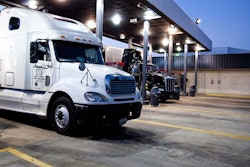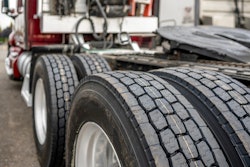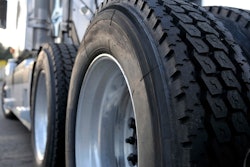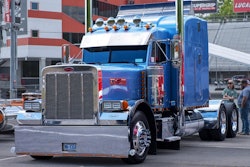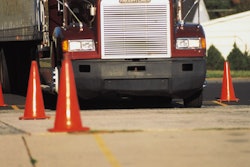In addition to reducing speed and idling, there are several other good fuel conservation practices, each of which can reduce your fuel bill by 1% to 3% -- or several hundred dollars a year:
WATCH CASH FLOW. Don’t tie up money needlessly in the fuel tank when downtime of a few days or more is expected. If you know a low-price area is on your route, don’t fill up at a more expensive stop; limit your purchase based on your mpg.
TAKE CARE WITH BIOFUEL. Biofuels tend to be expensive and produce lower fuel mileage. Know the level of biofuel (B20, for example, is 20% biofuel) that is allowed under your engine warranty, and use only fuels approved by your engine maker. Carry extra fuel filters, as biofuel can cause clogging.
MAXIMIZE STORAGE. Whether you’re buying a used or a new truck, opt for larger dual tanks. This gives you the option of pigging out on super-cheap fuel and cutting down on the number of fuel stops, saving time.
SPEC YOUR TRUCK WISELY. Your paycheck will show whether you chose a truck with a big engine and a lot of chrome, or a truck engineered to meet your business needs and help you succeed.
First, there is the initial extra expense for the purchase, then the added cost of fuel consumption. In fuel savings alone, an aerodynamic truck generally more than offsets the resale value of the stylish truck. It also yields greater load capacity, more comfort, less noise and higher profit.

On the other hand, operators with too-low horsepower settings for the application will find their feet always hard on the throttle, consuming more fuel. Some have benefited in fuel economy by retuning the engine control module for maximum fuel economy, installing full-flow mufflers or using one of several new engine/transmission combinations built for maximum mileage.
The move toward the automated manual transmission has brought with it parallel trends of downspeeding and lower axle ratios. This reduces the engine speed and results in savings at the pump. Every reduction of 100 rpm is worth about 1.5% in reduced fuel consumption. Being able to maintain highway speeds at 1,150 rpm versus 1,370 constitutes fuel savings of 3% or more.
[Related: Paths to 10-plus mpg in a Class 8 diesel tractor with aero, downspeeding, more]
PERFORM REGULAR MAINTENANCE. This ensures your truck is running efficiently. Also, check your current miles per gallon at each fill -- if it falls off, determine the reason. Start a preventive maintenance routine; check often enough to catch low oil, a dirty air filter or an air compressor leak.
MAINTAIN TIRE PRESSURE. To reduce rolling resistance, check air pressure in all 18 tires, and fill them up at least weekly to the manufacturer’s specifications. The trailer tires may belong to your carrier, but why pay the extra cost of pulling a trailer with underinflated tires?
SLOW YOUR ACCELERATION AND DECELERATION. Both will consume less fuel and be easier on your equipment. Slowing acceleration is especially important running on hills or in the mountains because it helps reduce the effects of gravity. Rapid acceleration gets you an extra few seconds but creates premature wear on the engine, driveline and tires -- along with increasing your fuel costs.
CUT OUT-OF-ROUTE MILES. If you’re like many owner-operators, with 6% to 10% of your miles out of route, you possibly could cut them by 3 percentage points. Doing so would save an extra 3% on fuel, as well as on other variable costs such as tires and maintenance. Rethinking your route, keeping side trips to a minimum and using precise directions will pay off in savings.
Getting a fuel surcharge
Since fuel prices surged two decades ago in the wake of Hurricane Katrina's disastrous landfall on the Gulf Coast, fuel surcharges have become widespread to help carriers and their operators guard against further price spikes.
Carriers often structure their surcharge scale by assuming a certain fuel efficiency, such as 6 miles per gallon. Some owner-operators make a healthy per-mile profit from their carriers’ surcharge because good fuel economy practices allow them to average better than 6 mpg. Surcharges traditionally have been based on the national average of diesel prices, in some cases regional averages or dynamic adjustments for prices along particular freight lanes.
At once, there are no rules covering fuel surcharges. As with freight rates, anything goes. Independents with authority can develop their own surcharges for contract rates quoted to shippers -- most brokers negotiate all-in rates irrespective of any added surcharge. Making certain those rates sufficiently cover current fuel costs with plenty of profit left over is key.
Fuel price volatility makes it difficult to negotiate long-term contracts, but long-term contracts are important. A surcharge allows those contracts to accommodate short-term price fluctuations.
[Related: A fuel crisis is here: Will only the strong survive?]
For example, Shipper A has a regularly scheduled load that leaves Cleveland every Wednesday to deliver in Dallas. The shipper would like to know that every Wednesday the load will be picked up by the same carrier. Shipper A would also like to know how much it’s going to cost. So the shipper and the carrier agree on a year-long contract with a base rate of $2 per mile plus a fuel surcharge. Now they need to work out a fuel-surcharge calculation.
The most commonly used formula is based on three things that involved parties agree upon:
- A base fuel price. This is commonly $1.25/gal. Any time the fuel is above the base price, the surcharge will be calculated and applied.
- Base fuel mileage. As noted, this is often 6 mpg, or tied to the carrier's average fuel mileage, in some more recent examples 7 mpg or in rare cases higher.
- The source and interval of the current fuel price. Typically it’s the U.S. Department of Energy's Energy Information Administration, which publishes national and regional average prices every Monday.
When a surcharge uses these factors, it clarifies the billing and protects all parties involved.
How to profit from the process. An increasingly efficient owner-operator can really make bank when fuel costs rise quickly. The national average diesel price was a whopping $5.54 per gallon (and above $6 in some regions) with the Memorial Day 2022 EIA publication of diesel prices, for instance. To calculate a fuel surcharge based on this price, here is the formula:
= $4.29
$4.29
÷ Miles per gallon: 6
= Fuel surcharge per mile: $0.72
Once you understand how surcharges work, you realize the potential for profit. Because fuel surcharge calculations involve some sort of fuel mileage average, a fuel-efficient owner-operator or small fleet owner who beats those averages pockets the difference in added profit.
At 6 mpg, the effective fuel price is the base level, $1.25. So let’s reverse the calculation, using mpg rates of 5 and 7, and compare your effective price.
First look at a truck getting 5 mpg:
Fuel surcharge $.72
X mpg: 5
= Effective surcharge/gal.: $3.60
Average fuel price: $5.54
— Effective surcharge/gal: $3.60
= Operator’s effective fuel price: $1.94
Do the same calculation at 7 mpg, and a fuel surcharge of 72 cents per mile means the owner-op or carrier pays only 50 cents/gal. for fuel, more than a buck less per gallon than the truck getting 5 mpg. Obviously, this generates a lot more profit.
Not only that, but the higher fuel prices go, the bigger the spread becomes for those getting high fuel mileage.
Read next: Fuel taxes: Finding the cheapest fuel about more than the pump price



